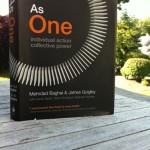For those who don’t know, Jim Quigley was, until June, the global CEO of Deloitte Touche Tohmatsu Limited, the largest of the Big 4 professional services firms. He has now stepped into the role of Senior Partner, Deloitte LLP. We caught up with him in China last March, and resolved to do this interview.
Genesis
Trusted Advisor Associates: Jim, this is an unusual book for several reasons. It’s got two lead authors, but five listed authors in total. It’s got a ton of organized research behind it, maybe the most since Good to Great. The book offers significant insight into this idea of collective behavior in organizations, and connects theory to practical examples by defining eight distinct leader-follower archetypes.
How did this book come about?
Jim Quigley: The book came about through the many discussions we’ve had with leaders all over the world. I’ve always been fascinated by leadership, and I’ve always tried to deepen my understanding of leadership as an art and a science, with important requirements that can be measured. I’ve observed many styles of leadership, both inside and outside of our firm.
My c-suite conversations with executives always included insights about the global economy and the status of the client’s relationship with Deloitte, but when I asked specific questions about leadership, the tone of the conversations changed dramatically. CEOs would lean forward and become deeply engaged, and would often confide that questions of leadership, commitment and strategic alignment are what keep them up at night. With the significant shifts that have occurred in the business environment, we decided the time was right for a fresh look at leadership.
Out of Many, One
TAA: For some reason, reading the book reminded me of the old US motto E pluribus unum—out of many, one. At a high level, isn’t that what the book is about—how to work as one?
What problem were you trying to solve, what question were you trying to answer, with this book?
Jim: Today’s business environment can be characterized as one of “constant change.” Business leaders are facing continued globalization of the economy and rapidly expanding emerging markets. The talent pool is being redefined through rapid technological and demographic shifts, and all around us we see new ways in which people are convening, collaborating and communicating with one another.
We believe that, against this backdrop, leaders from all sectors and organizations are searching for a pragmatic approach to realizing the full potential of their greatest resource: their people. We feel that collective behavior can be a significant, competitive force that can give an organization its winning edge. Leaders who can create unified teams – working together, as one, can produce extraordinary results.
TAA. The book describes 8 archetypes for how organizations operate. I’m guessing you started with the idea of archetypes—but how did you arrive at these eight?
Jim: We actually didn’t start with the archetypes, we discovered them. Conventional wisdom suggests that leadership styles fall somewhere between two extremes—a traditional command-and-control structure and a participatory, flatter, “modern” organization. In our research, we found a more nuanced picture, and found that organizations depend on vastly different leadership styles and structures.
We thoroughly analyzed 60 successful examples of As One behavior from a diverse selection of corporations, government agencies and non-profit organizations around the world. From these, we identified eight distinct models, each of which can work effectively when applied in the right situation.
8 Archetypes
TAA: Let’s help the reader out here. Can you define the 8 archetypes and give a simple example of each, so everyone knows what we’re talking about?
Jim: Sure.
The Landlord & Tenants archetype is a top-down model. In this relationship, the leader controls access to resources and dictates the terms their use. Tenants voluntarily decide to join the landlord because it’s in their interest to do so. Once they’re “in,” however, they have no choice but to abide by the rules. That said, the relationship isn’t entirely one way. Landlords’ power ultimately depends on the number of tenants they can attract and retain. It’s in their interests to be fair—and to encourage and reward the “right” behavior. The Apple App Store is a good example of a Landlord & Tenants archetype. Apple (“landlord”) built a virtual community of developers (“tenants”) by promising them a 70 percent share in the profits of successful applications for the iPhone and iPad. In exchange, app developers agree to abide by Apple’s strict guidelines.
At the opposite end of the spectrum, the Community Organizer & Volunteers pairing is based on the direction-setting power of followers. The leader is the glue that binds the activities of the volunteers together, providing the narrative and rationale for their actions, but the followers cannot be told what to do. The organization functions more by philosophy than by rigid rules and structures. The Linux operating system is a classic example, built by an ecosystem of developers, a community bound together by the belief that the world deserves an open-source software alternative.
In the Conductor & Orchestra model, there’s very little room for improvisation—but there is room to excel within the given boundaries. Some organizations, for example those in the healthcare sector, depend on the ability of its members to perform, with care and precision, repetitive and scripted tasks. The leader motivates the team partly by the promise of perfection—of being trained to do something they do well to the highest possible standards. Medco Health Solutions, for example, uses scripted processes to deliver more than 100 million prescriptions per year with exceptional accuracy, demonstrating how a leader can inspire an organization to greatness with precision and attention to detail.
The Producer & Creative Team archetype requires a charismatic leader capable of bringing together a team of highly skilled, independent individuals to achieve their objectives. The Producer’s vision guides the project; their carefully selected teams make it happen. Dissent is used to push creative boundaries. Long-term success depends on constant innovation and reinvention, combined with discipline to get the show on the road. Performance arts company Cirque du Soleil, which combines the diverse talents of thousands of people through creativity, energy, and hard work, is a good example of this archetype.
General & Soldiers combines command-and-control culture with a clear and compelling sense of purpose and mission. The general is the authority and provides orders and the soldiers, highly trained and focused on clearly defined and scripted tasks, carry them out. There is a high level of commitment to the overall mission, the organization and to each other. The Marriott hotel chain takes great strides to train and welcome entry-level employees into the Marriott family. By building a strong culture, providing clear paths to promotion and focusing on the personal and professional success of its employees, Marriott has achieved great success and has one of the lowest staff turnover rates in the hospitality sector.
In the Architect & Builders model, the architect has a blueprint or vision that he or she needs a team of highly-skilled builders – followers – to bring to life. The builders are master craftsmen and innovators capable of finding novel solutions to technical and practical problems. As interdependent links in a project management chain, they work to ambitious deadlines and milestones, mapped to deliberate work cycles. The development of the Tata Nano, the world’s cheapest car, can be said to have been achieved by an Architect & Builders model, where a strong leadership vision was translated into action by a team of skilled builders.
The Captain and Sports Team operates as a dynamic unit, adapting, often in real time, to new strategies and challenges. Members of the sports team have a strong sense of shared identity and see each other as equals; this is an archetype with minimal hierarchy. The hands-on leader is there, on the field, motivating and encouraging and directing the play. The dabbawalas, the lunch-box men who each day deliver hot meals to around 200,000 office workers in Mumbai, operate like a closely knit sports team, taking direction from mukadams, experienced hands, if a crisis occurs or the schedule slips. Their operation is so efficient, so effective, so closely coordinated that only one in six million of their deliveries fails to arrive on time.
Close to the Community Organizer & Volunteers archetype, Senator & Citizens is a very democratic model. Problems are tackled through the sharing of opinions and the debate of differing perspectives; solutions emerge from loose and fluid groupings. The senator provides guiding intelligence and oversees decision-making, but the followers work independently. In return for their personal freedom, citizens willingly commit to the “constitution” and to the responsibilities they owe to the collective. Structures are flat: it’s a community of equals. W. L. Gore & Associates, inventors of GORE-TEX®, is one of the world’s most innovative companies but has few job titles, no job descriptions, and no defined organizational charts.
TAA: Say a little more please about the idea of archetypes? Are they meant to explain behavior? Are they also guides to managers for action? What should or could a senior leader glean from the book? And what about less senior leaders? Consultative types?
Jim: None of the archetypes is, in and of itself, correct or incorrect. Leaders must select the one that best suits their and their organization’s objectives and circumstances. The book provides real-life examples of these different styles in action, and the hope is that leaders of organizations large and small can leverage the characteristics of the one that fits them best as they pursue collective behavior.
TAA: Can you be a little of one type of archetype and a little of another? Are there hybrids? Or does everything turn to oatmeal if you depart from pure models?
Jim: It’s perfectly possible, if not always desirable, for more than one archetype to co-exist. Some companies may make plans using one archetype, but then behave more like another archetype when it comes time to deliver. Live, real-time events often demand the kind of actions and responses that cannot be rehearsed. There’s always a script for a wedding—the order of service, the ceremony, for instance—but it doesn’t tell you what to do when the photographer doesn’t turn up.
The constant for an organization is not so much the archetype but the strategic question, “What are we trying to achieve and how are we going to get there?” Many corporate strategies call for establishing “one company” that will operate less expensively and more effectively across internal boundaries, operate more globally or in a way that provides a uniform customer experience. In the As One approach, this generally requires the organization to become more top-down and more scripted. A strategy focused on innovation, on the other hand, would call for a move toward the more creative dimension. Organizations, then, should expect to adapt their archetypes based on changing circumstances and objectives.
Archetypes, Trust and Relationships
TAA: The reason this book is on the Books We Trust list is that it has to do with organizations acting As One. That suggests a major role for trust and trusted relationships.
But how does trust play out? Does its importance vary by archetype? Is it historically more important these days? How does trust affect the various stakeholder relationships?
Jim: Naturally, trust lies at the heart of all successful relationships. Leaders need to earn the trust of their followers, both inside and outside of their organization. A trusting relationship is key to any archetype, any situation. Without trust as a foundation, it’s difficult—if not altogether impossible—for an organization to truly function collectively.
We live in an unprecedented era of skepticism, when confidence in businesses, government and other institutions is at a historic low. The case for trust has never been stronger, and I predict we will see the companies and leaders who thrive during this time are the ones that elevate trust as a core value.
TAA: Jim, thank you very much for taking the time to speak with us about As One; may you sell tons of books, and have the impact this book has the ability to deliver.
Jim: My pleasure. Thanks so much for the opportunity to share some of what we’ve learned.
 A doctor, a lawyer and a rabbi all walk into a bar.
A doctor, a lawyer and a rabbi all walk into a bar.
 When it comes to trust-building, stories are a powerful tool for both learning and change. Our new
When it comes to trust-building, stories are a powerful tool for both learning and change. Our new  You think you’ve got it under control. Signed, sealed, all but delivered. You are in charge.
You think you’ve got it under control. Signed, sealed, all but delivered. You are in charge. In my
In my  This is the fourth in a series called Books We Trust.
This is the fourth in a series called Books We Trust. When a child is untrustworthy, parenting is needed. When an adult is untrustworthy, counseling can help. When a company is untrustworthy, markets exact discipline.
When a child is untrustworthy, parenting is needed. When an adult is untrustworthy, counseling can help. When a company is untrustworthy, markets exact discipline.
 Anna Dutton is a Sales Operations Director for Blackboard, a company that brings technology to the world of education. Find out what Anna sees as the distinguishing traits of a trusted advisor, and learn two concrete steps she recommends for anyone who wants to bring more transparency and trust to their business relationships.
Anna Dutton is a Sales Operations Director for Blackboard, a company that brings technology to the world of education. Find out what Anna sees as the distinguishing traits of a trusted advisor, and learn two concrete steps she recommends for anyone who wants to bring more transparency and trust to their business relationships. Many people in this world work for tips alone. We think it’s about time that the tips start working for people.
Many people in this world work for tips alone. We think it’s about time that the tips start working for people.